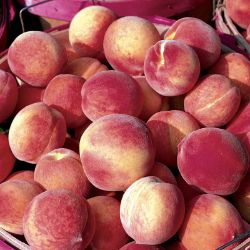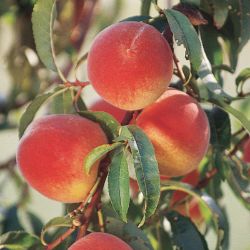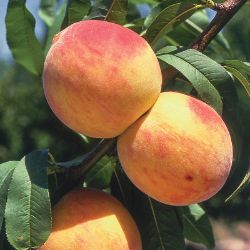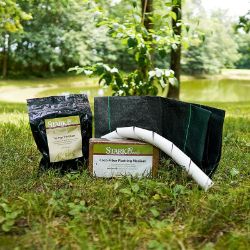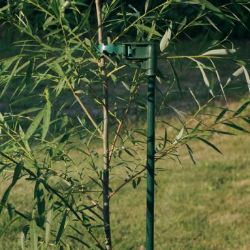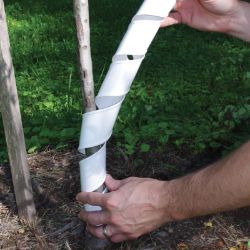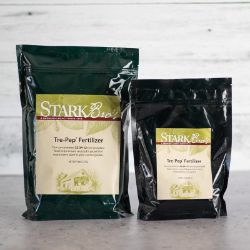Pest & Disease Control for Peach Trees
As it grows, a peach tree may show signs of pests or diseases. Factors such as location, weather, and upkeep play a part in which issues your peach tree encounters, and how well it stands up to them.
Disease-resistant peach trees are easy-care options for growers who prefer a low-spray or no-spray orchard, and — for all peach trees — routine maintenance* can help keep most problems at bay.
*Good maintenance practices include: adequate watering, fertilizing as needed, seasonal pruning, preventive and active spraying, fall cleanup, and winter protection.
NOTE: This is part 7 in a series of 11 articles. For a complete background on how to grow peach trees, we recommend starting from the beginning.
The following are merely intended as a means of identifying potential issues. Don’t be alarmed — a peach tree may experience a few of these in its lifetime, but certainly not all at once.
Peach Tree Pests
Aphids
Tiny, pinhead-sized insects, varying in color depending on the type. Will cluster on stems and under leaves, sucking plant juices.
Symptoms: Leaves curl, thicken, yellow, and die. Aphids produce large amounts of a sticky residue called “honeydew” that attracts insects like ants. Honeydew also becomes a growth medium for sooty mold.
Control: Spray
- GardenTech® Sevin® Concentrate Bug Killer
- Monterey Fruit Tree Spray Plus
Control: Natural Spray
- Monterey Fruit Tree Spray Plus
- Monterey Horticultural Oil
- Safer® Brand Insect Killing Soap
- Monterey Complete Disease Control
- Natural Guard® Neem
- Ferti-lome® Triple Action
Lygus Bugs and Stink Bugs
Lygus bugs are small oval insects that are brown, green, gray, or almost black with a yellow “V” on the back. Stink bugs are usually gray or brown, shield-shaped and about ½-inch long.
Symptoms: Lygus bugs damage fruit and blossoms. Stink bugs puncture fruit and suck out the juice, causing sunken spots on young fruit or deformed mature fruit (cat-facing). Both can be headed off by planting your peach trees away from hay fields, which serve as a host.
Control: Natural Spray
- Hi-Yield® Vegetable & Ornamental Insect Control
- Safer® Brand Insect Killing Soap
Oriental Fruit Moth
Pests and damage are similar to the Codling Moth. Adults are small, ½-inch grayish moths. Larvae are pinkish-white with a red-brown head, about ½-inch long. Pheromone traps are an option for luring moths.
Symptoms: Damage first appears on vegetative growth, and left untreated will eventually infest fruit. Larvae tunnel in through the stem and often exit near the pit.
Control: Spray
- Monterey Fruit Tree Spray Plus
Control: Natural Spray
- Monterey Horticultural Oil
- Safer® Brand Insect Killing Soap
- Hi-Yield® Vegetable & Ornamental Insect Control
Borers
Includes: American plum borer, Pacific flatheaded borer, Peach twig borer, Peachtree borer, Shot hole borer
These pests burrow and feed underneath the bark on the sapwood, weakening the tree and leading to death. Borers may target the graft location (in young peach trees) for laying eggs as well as damaged or sunken areas, and even a few inches below the soil line. Grubs have cream-colored bodies. Difficult to control once infested; preventive action is the best defense.
Symptoms: A thick, gummy substance (sap) leaking from round holes on the trunk or in a crotch of the tree. Grubs tunnel through trunks, weakening and eventually killing the tree. Eggs hatch and larvae tunnel into tree’s vascular tissue.
Control: Manual
- If infested, use a fine wire to try to pierce, mash, or dig grubs out.
- Traps (tanglefoot-coated logs or posts) can lure adults. Remove from site and burn after trapping.
- Preventive spraying (including the ground around the roots)
Control: Spray
- GardenTech® Sevin® Concentrate Bug Killer
Additional Resources
- Contact local county Cooperative Extension for further advice
Fall Webworm
This species is similar to the eastern tent caterpillar, but constructs its web over the end of the branch, rather than in tree crotches. It feeds on nearly all trees, excepting conifers. The webworm caterpillar is about an inch long with a black to reddish head and light yellow to greenish body with a mottled stripe of two rows of black tubercles and tufts of long whitish hairs. Adults appear as white moths with dark spots on the wings.
Symptoms: Branch ends are encased in a large web where larvae feed, skeletonizing the leaves.
Control: Manual
- Remove webs with a rake (caterpillars are removed with webs) and burn
Control: Spray
- Monterey Fruit Tree Spray Plus
Control: Natural Spray
- Monterey Horticultural Oil
- Safer® Brand Insect Killing Soap
- Natural Guard® Caterpillar Killer Spray w/BT
Leafroller
Small caterpillars, about an inch long in colors from pale yellow or green to brown. Leafrollers often have dark heads.
Symptoms: Leaves and blossoms are rolled and webbed together where larvae feed. Foliage eventually becomes skeletonized. Leafrollers do not burrow into fruit, but may scar it.
Control: Manual
Hand-removal of webbed foliage and keeping area free of weeds and debris may be enough to manage the pest.
Control: Spray
- GardenTech® Sevin® Concentrate Bug Killer
- Monterey Fruit Tree Spray Plus
Control: Natural Spray
- Monterey Horticultural Oil
- Hi-Yield® Vegetable & Ornamental Insect Control
- Natural Guard® Caterpillar Killer Spray w/BT
- Monterey Fruit Tree Spray Plus
- Ferti-lome® Triple Action
- Natural Guard® Neem
Nematodes
Includes: Root-knot nematodes, Ring nematodes, Lesion nematodes, Dagger nematodes
Nematodes (microscopic worms) live in the soil and in plant tissue, and can do a lot of damage to peach trees. Have the soil tested by your county extension agent prior to planting to determine the extent of their presence.
Symptoms: Nematodes perforate tissue cells and feed on them, usually damaging the roots. Tree growth is stunted and leaves may show signs of yellowing (chlorosis). Sandy soils are more susceptible.
Control: Preventive
Fumigate pre-planting (in the fall, while the temperature is still about 55 degrees), or alternate nematode-unfriendly cover crops. Purchasing peach trees with nematode-resistant rootstock is the best prevention.
Control: Spray
- Nimitz, a nematicide approved by the EPA in 2014, is a non-restricted use pesticide with less stringent regulatory restrictions and reporting guidelines than fumigators. As of mid-2016, it was not yet widely available in retail gardening stores.
Plum Curculio
Also Curculio beetle
Adult is brownish gray, 1/5-inch long, hard-shelled beetle with a long snout and 4 humps on its back.
Symptoms: Cuts a crescent-shaped hole in fruit skins and lays eggs inside. Grubs hatch and tunnel within fruit. Fruit may drop prematurely or have grubs/worms or tunnels inside at harvest.
Control: Manual
- Site Cleanup.
- Thin crescent-shape scarred fruit as soon as it appears.
- Remove dropped fruit as soon as it appears to avoid re-infestation.
Control: Natural Spray
- Natural Guard® Neem
Scale
Includes: San Jose Scale and other types of scale
Usually on bark of young twigs, branches. Gray, circular bumps protect the female, whose eggs hatch immediately into small yellow crawling insects. The young scale secrete a white wax, which eventually turns black. Scale may also be on the fruit.
Symptoms: Sap-feeding weakens the tree.
Control: Spray
- GardenTech® Sevin® Concentrate Bug Killer
- Monterey Fruit Tree Spray Plus
Control: Natural Spray
- Monterey Horticultural Oil
- Safer® Brand Insect Killing Soap
- Monterey Fruit Tree Spray Plus
- Ferti-lome® Triple Action
- Natural Guard® Neem
Tarnished Plant Bug
Yellowish-brown, winged insect that may have black spots or red stripes.
Symptoms: Damage is caused by injecting toxins into buds and shoots, causing stunted vegetative growth and sunken areas (often called “cat-facing”) on fruit.
Control: Natural Spray
- Safer® Brand Insect Killing Soap
- Monterey Fruit Tree Spray Plus
Tent Caterpillar
Adults are moths. Caterpillars are a hairy, grayish brown with cream-colored spots or stripes down the back.
Symptoms: Encases large areas in webbing and feeds on enclosed leaves.
Control: Manual
- Remove webs with a rake (caterpillars are removed with webs) and burn.
Control: Spray
- Monterey Fruit Tree Spray Plus
Control: Natural Spray
- Safer® Brand Insect Killing Soap
- Natural Guard® Caterpillar Killer Spray w/BT
Thrips
Tiny, slender, fringed-wing insects ranging from 1/25-inch to 1/8-inch long. Nymphs are pale yellow and highly active. Adults are usually black or yellow-brown, but may have red, black, or white markings.
Symptoms: Feeding occurs on vegetation by puncturing and sucking up the contents, causing appearance to be deformed or discolored (similar to damage by mites and lace bugs).
Control: Natural Spray
- Monterey Fruit Tree Spray Plus
- Safer® Brand Insect Killing Soap
- Monterey Horticultural Oil
Peach Tree Diseases
Anthracnose
Also “bitter rot” of peaches
Anthracnose is an infection that affects many species of fruit trees, including peach. Most of the damage is cosmetic, but still needs to be controlled. Rain and irrigation systems can spread the disease, which tends to occur in warm, wet weather.
Symptoms: Anthracnose of peach trees usually occurs on ripe or nearly ripe fruit. Small brown or tan lesions, which enlarge and darken, gradually become circular and slightly indented. In early stages, these lesions may be confused with those of brown, black or white rot, but anthracnose spots are firmer and bigger, and are often accompanied by rings of pink spore masses. Leaves and twigs remain unaffected. Anthracnose will not kill the tree, but will damage the fruit/yield.
Control: Spray
- Hi-Yield® Captan 50W Fungicide
Control: Natural Spray
- Monterey Liquid Copper Fungicide
- Natural Guard® Neem
- Monterey Fruit Tree Spray Plus
Armillaria Root Rot
Also “oak root fungus”, “shoestring rot”, and "mushroom rot"
All stone-fruit rootstocks are susceptible to Armillaria root rot, which smells distinctly like mushrooms and occurs on the upper roots and/or crown of the tree. This destructive fungus lives within dead and living roots is transferred from root system to root system. It can live for up to 30 years.
Symptoms: Roots infected with Armillaria mellea have whitish-yellow fan-shaped mats between the bark and the wood. The tree trunk is girdled. Dull, yellowed, or wilted foliage is usually the first sign of trouble; infected trees usually die slowly.
Control: Manual
Exposing an infected crown and upper root area of a peach tree may help to slow its growth into the crown. In spring, remove soil from around the base of the tree to a depth of 9 to 12 inches. Leave the trunk exposed for the remainder of the growing season. During the spring, summer, and fall, keep the upper roots and crown area as dry as possible. Recheck the hole every few years to make sure it has not filled in with leaves, soil, and other matter; the hole must be kept open and the crown and upper roots exposed.
Brown Rot
Also "mummy rot"
Brown rot is a fungal disease that commonly affects stone-fruit trees, including peach trees, especially after a long, warm, wet spring. It is one of the most common peach-tree diseases. It affects the fruit tree’s flowers and fruit crop, but is not fatal. Fortunately, brown rot is easy to spot, prevent, and treat.
Symptoms: Blossoms may brown or wilt. Dark sunken spots appear on new shoots, and leaves on infected limbs will be brown and droopy. Affected fruit develops small spots of rot that enlarge quickly, developing fuzzy tan/grey spores that cover the fruit surface. If left on the tree, fruit shrivels, darkens, and hardens into “mummies.”
Control: Manual
Plant a resistant variety, like Venture in a well-drained location. Prune regularly to keep trees open to light and air circulation, and remove any pruning debris, damaged or diseased fruit and limbs, as well as fallen fruit to avoid sites for fungi to thrive (do not compost). Thin fruit to avoid good fruit touching infected fruit. Disinfect your pruners between cuts to avoid spreading the fungi.
Control: Spray
- Monterey Liquid Copper Fungicide
- Hi-Yield® Captan 50W Fungicide
- Ferti-lome® Broad Spectrum Landscape & Garden Fungicide
Spray preventatively if brown rot is problematic in your area, even before symptoms appear.
Canker (bacterial and cytospora)
Cytospora canker is caused by the fungus Cytospora spp. and attacks trees via weak or injured bark. Bacterial canker is caused by Pseudomonas syringae. Both tend to occur during cool, wet weather. They act and are treated similarly.
Symptoms: Infection appears as yellow-orange and black regions that later ooze a gummy substance which may have a foul odor. Cankers eventually develop in the branches, encompassing the circumference of the wood until it dies.
Control: Manual
Prune off infected twigs and limbs where cankers have affected the branch. Cut out cankers that are less than half the branch circumference. Use a small, sharp knife and score the wood all the way around the canker, about an inch away from it. Dig the tip of the knife into the wood and bark as you work, and maintain a 1-inch margin around the circumference of the canker.
Slip the knife under the bark and remove the diseased inner bark, which is usually a rusty brown color. Round the edges of each incision to promote rapid healing, but do not remove the wood from the uninfected area below the canker.
Clean up any wood chips or debris and either burn it or dispose of it in the trash. Do not compost infected debris. Bleach the knife used to excise the canker, rinse and pat dry.
Apply fungicide spray to small wounds during wet periods and during dormant periods.
Control: Spray
- Hi-Yield® Captan 50W Fungicide
Control: Natural Spray
- Monterey Liquid Copper Fungicide
Crown Gall
Caused by Agrobacterium tumefaciens — a bacterium that inhabits the soil and causes rapid, abnormal growth (developing into galls). Can spread through injury to roots in the soil as well as through gardening tools carrying the bacterium.
Symptoms: Trees appear stunted and slow growing; leaves may be reduced in size. In mature, fruit-bearing aged trees, may see little or no fruit. Woody, tumor-like growths called galls appear, especially at the crown (ground level) and below. Growths can restrict water and nutrient flow, but often the damage isn’t extensive enough to cause immediate or total death. If tree has died, inspect roots for hard, woody ‘tumors’ to identify Crown Gall as the cause. Note: Crown Gall is not the only thing that can cause stunted trees.
Control: Prevention
- Purchase gall-free nursery stock. Crown gall symptoms are generally well developed on finished nursery stock, making inspection a useful prevention strategy.
Additional Resources
- Contact local county Cooperative Extension agent for further advice
Peach Leaf Curl
This is a common fungal disease that affects peaches and nectarines. Leaf curl can severely inhibit fruit production. Disease fungi overwinter underneath the bark, around buds and in other protected areas. During cool, wet spring weather, the spores infect new leaves as they emerge from the buds. Later, the fungus produces millions of new spores, which are splashed or blown from tree to tree.
Symptoms: Leaf curl shows up in the spring as reddish areas on new leaves, which then thicken and crinkle, causing them to “curl.” Spray the whole tree after most all of leaves have dropped in the fall, and again in the early spring, just before buds open.
Control: Manual
- Select resistant varieties whenever possible.
- Keep the ground free of leaves and debris, especially over the winter.
- Prune and destroy infected plant parts as soon as you see them.
Control: Natural Spray
- Monterey Liquid Copper Fungicide
- Monterey Fruit Tree Spray Plus
- Monterey Horticultural Oil
Phytophthora Root Rot and Crown Rot
Soil pathogens in the genus Phytophthora can cause crown and root rot diseases of almost all fruit and nut trees, as well as most ornamental trees and shrubs. This disease appears if the soil around the base of the tree remains wet for prolonged periods, or when the tree is planted too deeply.
Symptoms: Infected trees often wilt and die quick as soon as the weather warms up. Leaves may turn dull green, yellow, or even red or purplish. Symptoms may develop first on one branch then spread to the rest of the tree. Dark areas appear in the bark around the crown and upper roots. Gummy sap may ooze from the diseased trunk. Reddish-brown areas may show between the bark and wood.
Control: Manual
Good water management/drainage is the key to prevention. Never cover the graft union with soil and try to avoid direct watering of the crown. If you suspect crown rot, carefully cut away affected bark at the soil line. Trees can sometimes be saved by removing soil from the base of the tree down to the upper roots and allowing the crown tissue to dry out.
Control: Spray
- Hi-Yield® Vegetable & Ornamental Insect Control
- Ferti-lome® Broad Spectrum Landscape & Garden Fungicide
Control: Natural Spray
- Monterey Liquid Copper Fungicide
Powdery Mildew
Caused by Podosphaera leucotricha — a fungus that overwinters in buds and emerges during humid, warm weather progressively throughout the growing season.
Symptoms: Whitish-gray powdery mold or felt-like patches on buds, young leaves, and twigs. Leaves may crinkle and curl upward. New shoots are stunted.
Control: Natural Spray
- Monterey Liquid Copper Fungicide
- Monterey Fruit Tree Spray Plus
- Monterey Horticultural Oil
Rust
“Tranzschelia discolor”, commonly referred to as rust, overwinters in twigs or in leaves on the tree. A preventive fungicidal regimen is recommended: apply fungicide one, two and three months before harvest in areas prone to early-season outbreaks of the disease, and post-harvest in areas where disease is less of a problem, or emerges late-season.
Symptoms: Rust causes cankers to form on branches, followed by the appearance of pale yellow-green spots on both upper and lower leaf surfaces. The spots have an angular shape and eventually turn bright yellow. Spots on leaf undersides develop brown/orange spores. In some areas, rust damage extends to the fruit.
Control: Spray
- Hi-Yield® Captan 50W Fungicide
- Ferti-lome® Broad Spectrum Landscape & Garden Fungicide
Control: Natural Spray
- Monterey Liquid Copper Fungicide
Scab
Caused by Venturia inaequalis — a fungus that overwinters in fallen leaves and pruning debris. Favors cool, wet weather (typically in spring).
Symptoms: Spots on young leaves are velvety and olive green, then turn black; leaves wither, curl and drop. Fruit also has spots, is deformed, knotty, cracked and drops.
Control: Manual
- Plant scab-resistant peach trees if possible, especially in areas where peach scab is a known issue
- Remove and dispose of pruning debris. Fall clean-up is essential to controlling overwintering fungus.
Control: Spray
- Monterey Fruit Tree Spray Plus
- Hi-Yield® Captan 50W Fungicide
Control: Natural Spray
- Monterey Fruit Tree Spray Plusy
Additional Resources:
- Contact local county Cooperative Extension for further advice (including recommended scab-resistant varieties that are known to perform well in the area)
Shot Hole Blight (coryneum blight)
This disease gets the name from infections that appear as small tan spots on young leaves. The spots turn brown with purple borders, and the spotted areas eventually drop out of the leaf, appearing as if they were hit with a BB gun or buckshot.
Symptoms: Small, red-brown or purplish spots occur on new leaves and shoots. The spots expand, and the center turns brown. Tiny, dark specks sometimes form in the center of lesions, especially on leaves. Spots on young leaves have a narrow, light green or yellow margin and their centers often fall out as leaves expand, leaving “shot holes.”
Peach tree buds are killed in the winter. Fruit may become rough, with spotting on the surface. Circular lesions may develop on branches.
Some varieties may be less susceptible, so choose carefully. Where disease incidence is high, fungicides may be applied. On peach trees, a dormant spray of copper fungicide in late fall will work well.
Control: Manual
- Keep the ground free of leaves and debris, especially over the winter.
- Prune and destroy infected plant parts as soon as you see them.
- Avoid overhead sprinklers to keep foliage drier.
Control: Natural Spray
- Monterey Liquid Copper Fungicide
- Monterey Horticultural Oil
Other Peach Tree Issues
No Blossoms or Fruit
Peach trees take about 2 to 4 years after planting (on average) before they bloom or bear fruit. If enough time has been allowed to pass, and the peach tree is otherwise healthy, there are a few things to do to help it become fruitful.
- Make sure a pollinator variety is present. Most peach trees are self-fruitful and do not require another different variety of peach tree to bear fruit, but be sure to check that this applies to the variety you are growing. If a pollinator is required, choose another compatible peach variety.
- Make sure your peach tree variety is recommended for your zone. Low winter temperatures can injure sensitive fruit buds, hindering fruit production.
- Space trees far enough apart to help avoid nutrient or light competition. Adequate space encourages a healthy and productive tree. Spacing can be estimated by the mature spread of the tree.
- Prune to help keep the fruiting wood and vegetative wood in balance so that there isn’t too much leaf development in lieu of blossom development in mature trees — or too much fruit-bud development and not enough leaves to “feed” the fruit.
- Know your soil. Soil conditions, and the presence of necessary nutrients, help keep a peach tree’s roots supplying nutrients through its vascular system. If the soil is poor, or poorly drained, this affects the health and viability of the tree as a whole. If the tree is being over-fertilized, especially with a fertilizer high in nitrogen, it may develop lush, vegetative growth (leaves and branches) instead of developing fruit buds or blooming.
Additional Resources:
Sunscald and Sunburn (Scorching)
Sunscald/sunburn occurs during hot, dry growing seasons — with or without humidity in the air, but most commonly when humidity is low. Sunscald is also called winter injury or “southwest injury” as it commonly affects the southwest side of tree trunks during winter. Brown, crispy edges appear on leaves. Warm, clear days cause bark to expand and nights that are several degrees cooler will cause the bark to contract, damaging cells and causing splits and cracks in the trunk.
- Protect trunks prior to winter with tree guards or a diluted solution of water and white latex paint (50/50).
- Water new trees every 7 to 10 days during the growing season (if there is no rain within the week), or as needed (as the soil becomes dry to the touch).
- During the growing season, consider constructing a temporary shade cloth to protect trees from the sun on hot, dry days. Water as needed (see above).
Additional Resources:
Water Stress
Can be caused by both overwatering and underwatering. Overwatering commonly presents as pale green to yellow leaves and leaf drop, which can weaken a tree, lead to root rot, and ultimately kill the tree. Underwatering often presents as discolored (usually yellowed), dry leaves. Tree may appear to wilt overall. Prolonged lack of water can kill the tree.
- Water new trees every 7 to 10 days during the growing season (if there is no rain within the week) or as needed (as the soil becomes dry to the touch).
- If planted in a location where the soil does not adequately drain water after heavy rains (leading to standing water), relocate the tree as soon as possible.
- If drought-like conditions persist, consider slow-trickle drip irrigation to allow water to reach the roots rather than wash over soil surface.
Additional Resources:
Wind Injury
Symptoms: Can involve injury such as leaning/uprooted trees, breaks, tears, or wind-burned foliage. Depending on the severity of the injury, a peach tree can either bounce back from minor damage or succumb to the wind-caused harm. This is determined on an individual basis and the health of the tree before the damage occurred.
Control: Manual
- Adequately tamp soil around the tree’s roots (and thoroughly water) at planting time to remove air pockets and ensure good contact with the soil. Air pockets and loose soil around the roots can cause the tree to rock easily, leaving it vulnerable to leaning or uprooting.
- Use tree stakes for new trees, dwarf trees, and trees planted in high-wind areas to help support upright growth and avoid leaning, uprooting, and breaking.
- Selectively thin fruit that may be weighing down limbs to reduce stress from the weight, and avoid tears or breaks during gusty weather. Be aware: pests and disease may also take advantage of resulting broken or torn areas if damage occurs.
If tender new foliage is blown or whipped around by the wind, it may appear discolored (dark — like a burn or bruise). Damaged leaves can be removed to encourage healthy, new growth.














